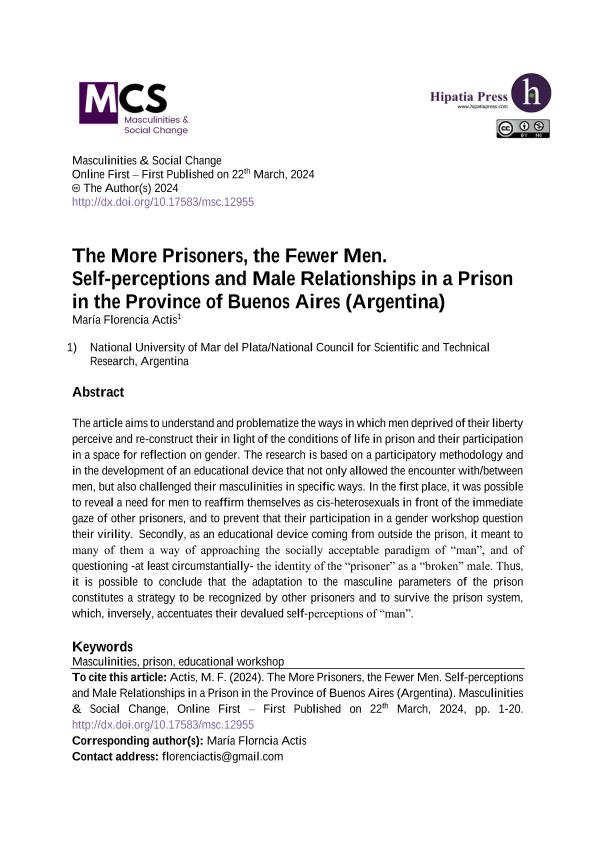Artículo
El artículo tiene como objetivo conocer y problematizar las formas en que los varones privados de la libertad perciben y re-construyen sus masculinidades a luz de las condiciones de vida intracarcelarias, y de su participación en un espacio de reflexión sobre género. Se trabajó a partir de una metodología participativa y de un dispositivo educativo que no sólo permitió el encuentro con/entre varones, sino que también interpeló sus masculinidades de modos específicos. En primer lugar, se pudo relevar una necesidad de los varones de reafirmarse como cis-heterosexuales ante la mirada inmediata de otros presos, y de evitar que su participación en un taller de estas cualidades temáticas ponga en duda su virilidad. En segundo lugar, por ser un espacio educativo proveniente del afuera de la cárcel, representó para muchos una forma de acercarse al paradigma de “hombre” socialmente aceptable, y de cuestionar -al menos de manera circunstancial- la identidad del “preso” en tanto varón “quebrado”. De este modo, es posible concluir que la adecuación a los parámetros masculinos de la cárcel constituye una estrategia para ser reconocido por otros presos y sobrevivir al sistema carcelario, que, inversamente, acentúa sus autopercepciones devaluadas de “hombre”. The article aims to understand and problematize the ways in which men deprived of their liberty perceive and re-construct their in light of the conditions of life in prison and their participation in a space for reflection on gender. The research is based on a participatory methodology and in the development of an educational device that not only allowed the encounter with/between men, but also challenged their masculinities in specific ways. In the first place, it was possible to reveal a need for men to reaffirm themselves as cis-heterosexuals in front of the immediate gaze of other prisoners, and to prevent that their participation in a gender workshop question their virility. Secondly, as an educational device coming from outside the prison, it meant to many of them a way of approaching the socially acceptable paradigm of “man”, and of questioning -at least circumstantially- the identity of the “prisoner” as a “broken” male. Thus, it is possible to conclude that the adaptation to the masculine parameters of the prison constitutes a strategy to be recognized by other prisoners and to survive the prison system, which, inversely, accentuates their devalued self-perceptions of “man”.
Cuanto más presos, menos hombres: autopercepciones y relaciones masculinas en una cárcel de la provincia de Buenos Aires (Argentina)
Título:
The More Prisoners, the Fewer Men: Self-perceptions and Male Relationships in a Prison in the Province of Buenos Aires (Argentina)
Fecha de publicación:
03/2024
Editorial:
Hipatia Press
Revista:
Masculinidades y Cambio Social
ISSN:
2014-3605
Idioma:
Español
Tipo de recurso:
Artículo publicado
Clasificación temática:
Resumen
Palabras clave:
MASCULINIDADES
,
CÁRCEL
,
TALLER EDUCATIVO
Archivos asociados
Licencia
Identificadores
Colecciones
Articulos(CCT - MAR DEL PLATA)
Articulos de CTRO.CIENTIFICO TECNOL.CONICET - MAR DEL PLATA
Articulos de CTRO.CIENTIFICO TECNOL.CONICET - MAR DEL PLATA
Citación
Actis, María Florencia; Cuanto más presos, menos hombres: autopercepciones y relaciones masculinas en una cárcel de la provincia de Buenos Aires (Argentina); Hipatia Press; Masculinidades y Cambio Social; 2024; 3-2024; 1-20
Compartir
Altmétricas




